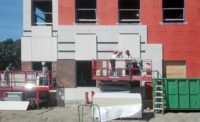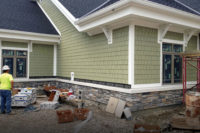For years, Portland and gypsum cement-based plasters have been used to produce fire resistant walls. When we look at modern building codes, Portland and gypsum cement-based plasters are classified as non-combustible and are still used to construct fire-resistant wall assemblies. Advances in building practices and materials have forced the industry to develop new tools to ensure our modern high-performance buildings are safe.
Looking at the two chemistries, applied an identical way, to identical thicknesses, gypsum-based plasters typically provide greater fire protection than Portland cement-based plasters. A plethora of historic test results have led the industry to determine that, in general, both materials can be used to construct a one-hour fire-rated wall. While both chemistries can be used, the thickness varies. Gypsum-based plaster at 5/8-inch is sufficient to produce a one-hour fire-rated wall. Portland cement-based plaster needs to be 7/8-inch to achieve similar results.
One-coat stucco systems have gained prominence in the marketplace. One-coat stucco materials also can provide a one-hour rated wall assembly provided they have a current code report from a recognized certifying body. By certifying body, we mean organizations like IAPMO, ICC and Intertek.
Fire Resistance Testing
Modern regulatory and legislative building codes are placing ever-increasing performance demands on the modern wall assembly. Whether for increased R-value, reduced air penetration, light-weight materials, rainscreens or any number of other requirements, the modern wall is now a complex assembly of both combustible and noncombustible materials that still need to meet a one-hour fire rating. Hence the challenge: how to ensure a wall assembly consisting of both combustible and noncombustible materials can provide the required one-hour rating. To solve this conundrum, the National Fire Protection Association developed a standard that allowed for fire resistance testing wall assemblies where both combustible and noncombustible materials are incorporated (NFPA 285).
NFPA 285 differs from historic flame testing in that it tests the whole assembly and not just the individual components. Individual component tests such as ASTM E84 Standard Test Method for Surface Burning Characteristics of Building Materials, sometimes called the Steiner Tunnel test, can provide you an approximation of the flame spread characteristics of a material and an estimation as to how much smoke will be generated. They do not provide data as to how much “energy” they will add to the system when it burns. Tests like ASTM E1354 Standard Test Method for Heat and Visible Smoke Release Rates for Materials and Products Using an Oxygen Consumption, sometime referred to as a Cone Calorimeter test, can help users understand how much energy may be added to a fire by an individual component while providing a more accurate picture of the smoke generated. What it does not establish is how all of the individual components of a wall assembly will interact under the extreme circumstances of a catastrophic event such as a fire. In comes NFPA 285.
Building Code Regulations
Born in the mid-1970s, during the energy crisis, NFPA 285 was developed to address the concerns of building code regulators as more and more combustible insulation was being included in wall assemblies. NFPA 285 provides a tool to evaluate the whole wall assembly and still the fears of fire inspectors and regulatory bodies.
Today, NFPA 285 has had a profound impact on the construction industry. It can be found referenced in numerous places in the building code and regulation. With one-coat stucco, any time it is used in a structure over 40 feet or when it is used as cladding on a structure with continuous insulation regardless of height, the wall assembly must have passed NFPA 285. It may help the reader to better understand the significance of the test if we go into a brief overview of what the test entails. NFPA 285:
- Used for non-load bearing exterior walls that need to be non-combustible but have some combustible components.
- Combustible components of the wall typically include foam, plastic, air and weather barriers (both sheet and fluid applied) laminates, furring strips, rain screens, fiber reinforced panels, etc.
- Looks at flame spread both horizontally and vertically.
- May be applied to exterior wall assemblies in type I, II, III, and IV construction.
- Referenced in IBC.
- Test fixture is “two” stories tall with a total height of 15 feet, 8 inches.
- Consists of two rooms approximately 10x10x7.
- The wall assembly is 17 feet, 6 inches tall and 13 feet, 4 inches wide.
- The wall assembly includes a window opening that is 30 inches tall and 78 inches long.
- The exterior of the wall is constructed exactly as the assembly would be in the field.
- The interior of the wall is finished with 1/2-inch gypsum board.
- The wall assembly and test fixture are filled with thermocouples to measure the temperature in multiple locations in each of the “rooms” interior walls, throughout the second-floor room, and through the interior of the wall assembly.
- There are strict guidelines as to the maximum temperature any one thermocouple may reach along with other stipulations as to the average maximum temperature of any group of thermocouples.
- NFPA 285 is designed to simulate what happens when an interior fire flashes over and starts burning the exterior of a structure.
- It is a 30 minute test.
- For the first five minutes the flame is restricted to the first-floor room of the test fixture.
- Temperatures in the room typically reach ≈1,150 degrees Fahrenheit.
- After five minutes an exterior burner is lit in the window opening of the test wall.
- This is kept burning for the next 25 minutes.
- Typical temperatures once the “flashover” has occurred reach ≈1,650 degrees Fahrenheit.
If we look at the “typical” construction for a multi-family wood frame constructed structure, we would expect to see:
- Gypsum board
- FR wood studs
- OSB
- An air weather barrier
- (sheet or fluid applied)
- Rainscreen
- Metal lath
- One coat stucco
Will it Pass?
In this assembly, the only non-flammable materials are the stucco and the metal lath. While at first glance a wall assembly may not seem likely to pass, this particular assembly does pass if the right materials are selected.
For example, not all air weather barriers will work—only ones that have been tested and have passed this specific assembly. Which brings up an important point: Individual products cannot be labeled as “passing” NFPA 285. Individual products can be labeled as passing NFPA 285 for a particular assembly.
The challenge is the multitude of assemblies that exist in the market today. The implication would be that each component of an assembly would have to be individually tested in each possible assembly to be compliant. That would be both cost and time prohibitive since a single test can be costly and requires considerable time to plan and perform. What is typically performed is testing to the worst-case scenario. Once the worst-case passable scenario is established then qualified engineers can perform evaluations to determine what other products or assemblies would be covered under the auspices of the testing.
Regardless of your niche in the overall construction industry, the continued proliferation of NFPA 285 will eventually affect everyone from the designer to the installer. A better understand of NFPA 285, its application, and how different wall assemblies may present a challenge to construct, will help one determine how NFPA 285 will impact ones business going forward. W&C
References
- www.iapmo.org
- www.iccsafe.org/
- www.intertek.com
- www.NFPA.orgteiner
- www.nfpa.org/.../list-of-codes-and-standards/detail?code=285
- www.astm.org/Standards/E84.htm
- www.astm.org/search/fullsite-search.html?query=e1354&
- per IBC section 2603.5.5 the exception is one story, sprinkled buildings, that incorporate foam plastic insulation
- www.iccsafe.org/















Report Abusive Comment